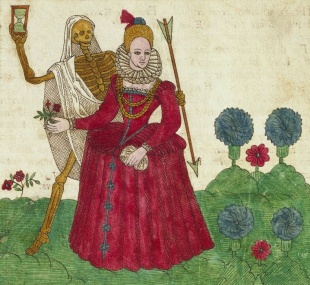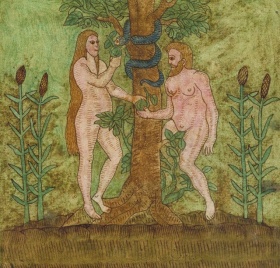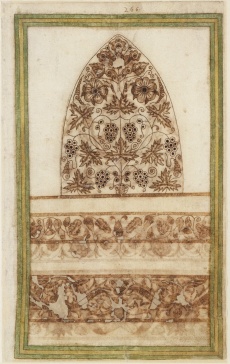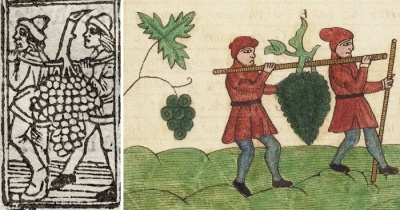Word & Image: The Trevelyon Miscellany of 1608

Word & Image: The Trevelyon Miscellany of 1608, part of the Exhibitions at the Folger, opened on January 23, 2004 and closed on May 22, 2004. The exhibition was curated by Heather Wolfe, Curator of Manuscripts, Erin Blake, Curator of Art, Rachel Doggett, Curator of Books, and Frank Mowery, Head of Conservation. A limited-edition facsimile printed on archival paper, Smyth sewn, and bound in cloth-wrapped boards with a reinforced spine and full-color dust jacket can be purchased from the Folger Shop. Major support for Folger exhibitions comes from The Winton and Carolyn Blount Exhibition Fund.
The Trevelyon Miscellany is not a book to be read from beginning to end. Start anywhere and savor the vibrant patterns, moralizing rhymes, historical and scriptural texts, and colorful pictures—the dialogue between word and image that makes it a unique mixture of many familiar genres.
Thomas Trevelyon's 600-page manuscript can best be described as a prototype coffee table book, created for the entertainment, education, and edification of his friends and family. The subject matter leaps from mundane to mythical, poetic to practical. Familiar scenes of domesticity and husbandry are intertwined with epic religious and political epitomes.
Trevelyon trawled chronicles, almanacs, broadsides, emblem books, and the Bible for his source material, appropriating texts and images from an unknown number of books, woodcuts, and engravings. But one could hardly accuse him of lacking an imagination. While most of the drawings are amusingly primitive, the overall effect is extraordinary. Viewing the pages individually, one loses the impact of his use of repeated visual imagery and ornamental borders. The manuscript is an attempt to create order and calm out of a disorderly and chaotic world.
Beginning in 1995, Folger conservators restored the entire manuscript, reversing earlier repairs, removing patches, and strengthening the pages. As well as offering a rare snapshot of the concerns and interests of a well-read London craftsman in Shakespeare's England, the exhibition celebrates the completion of this ambitious project.
View the entirety of the Trevelyon Miscellany in high-resolution Book Reader view in the Folger's Digital image collection.
Exhibition material
Thomas Trevelyon: the man and his sources
Thomas Trevelyon was sixty years old when he created what is now known as "The Trevelyon Miscellany." While the compiler reveals little about himself in the manuscript, he reveals much about the mental world of ordinary Protestant Londoners in the early seventeenth century. In order to make his book, Trevelyon copied and adapted material from a variety of sources, ranging from tiny almanacs to large chronicles to individual woodcuts.
Trevelyon lists thirty-three sources at the top of the page: "The Names of the Authour In this Booke Alledged." However, these are not the authors that Trevelyon used for his book, but the ones that John Stow used for his. Trevelyon copied this list from Stow's A summarie of Englyshe chronicles (London, 1565). He took other material from Stow as well, including descriptions of England, Scotland, Wales, and Cornwall, descriptions of the Oxford and Cambridge colleges, and "A Perfect Rule to know the beginning and ending of every Tearme."
History and Religion
Learning from the exploits and conflicts of the past was considered a profitable exercise in early modern England. In the aftermath of the Reformation, Holinshed, Stow, Camden, and others published massive chronicles of Britain beginning with the mythical founding by Brutus and continuing to the present day. John Foxe's Acts and Monuments, first published five years after the death of Catholic Queen Mary, documented the martyrdoms of early Christians and contemporary Protestants and stressed the continuous survival of "true" Christianity (i.e., Protestantism). Like his sources, Trevelyon's chronological histories not only emphasized his country's ancient lineage and Protestant faith, but also imposed a sense of continuity on an otherwise turbulent past.
"A brief computation of the time" serves as the beginning of the Miscellany since the first two leaves are lost. Copied from a 1609 almanac by Edward Pond, it begins with the creation of the world and ends with James I's accession. Classical and biblical events give way to more recent ones: the invention of the printing press, outbreaks of plague and sweating sickness, a blazing star, snow, an earthquake, the earls' rebellion, and the camp at Tilbury. Updated each year, the list appears in a slightly different form in almanacs by John White and others.
Calendars and Calculations
The calendar that governed the lives of Trevelyon and his contemporaries was the calendar of the Christian church year, which centered around the date of Easter. Before printed calendars in prayer books and almanacs became readily available, one needed the skill of time reckoning, or "Computus," to determine the dates of Easter and the other movable feasts. Calendrical tables in prayer books and early almanacs were often paired with images of "the labors of the months," entertaining illustrations that had a long tradition. By Trevelyon's time these images had mostly disappeared from almanacs, while the practical tables remained. Nevertheless, representations of seasonal agricultural tasks continued to be a reassuring part of the visual culture Trevelyon recorded.
The two men harvesting grapes in the image for September appear to have been copied from a small woodcut in The Shepardes Kalender.
The accompanying tables, shown above, follow the format of printed almanacs, giving saints' days, time of sunset, and other practical information.
Note the columns of "evill dayes" and "good dayes," probably derived from an edition of Leonard Digges's Prognostication Everlasting which contained tables of good and evil days to let blood, to purge, and to bathe.
Memento Mori
What might seem gruesome today was simply an omnipresent fact of life in early modern times. For Thomas Trevelyon, death marked a step towards eternal life, which could be spent in heaven or in hell. Memento mori or "reminders of death" filled the world in which he lived lest people forget that—depending on God's will and their behavior on earth—all eternity could be spent in torment.
In this "Dialogue against worldly vanytie" a Lady protests to Death that he must have made a mistake. She tells him she is too young, rich, and beautiful to die and merely has "some fume" the doctor can purge in the morning. Death mockingly appeals to her concern for wealth, saying he'll save the doctor's "charge" by taking her that evening. More importantly, he reminds her "your heaven is hell, except you do repent."
Proverbs
Proverbs, or short sayings expressing truths familiar to all, are scattered throughout the Trevelyon Miscellany. Some of the proverbs are secular, based on common observations and beliefs relating to aging and household responsibilities. Others are scriptural, gathered from various books of the Bible to depict specific temptations. Trevelyon often grouped proverbs together under individual illustrated topics, such as "usury" or "malice."
Trevelyon took his text from one source and his decorations from another for this page. The adages come from Thomas Tusser's oft-printed manual, Five Hundred Points of Good Husbandry, while the ornamental compartments are copied from other books. This compartment was used on title pages by the printer John Day in the mid to late sixteenth century, including his edition of the Bible (1551). The printer John Wayland used the same block in Bieston's The Bayte and Snare of Fortune (ca. 1557).
Trevelyon copied this architectural title-page border as a compartment for the proverb "The Ape, the Lyon, the Fox, the Asse." The border was first used by the printer John Day and later was adapted by others, including John Wayland, printer of The bayte & snare of fortune. Day's printer's mark at the base of the border was a visual pun on his name: a sleeper being awakened before a rising sun, illustrating his motto, "Arise, for it is Day." Trevelyon copied only the sleeper being awakened.
The Old Testament

Drawn, painted, and printed pictures had a powerful impact at all levels of society, with Bible scenes holding a particular fascination. Trevelyon was undoubtedly familiar with the popular scriptural illustrations of Hans Sebald Beham, Hans Holbein, Bernard Salomon, and others. Such images were copied not only onto paper but also converted into embroidery, painted on walls, carved in wood, and turned into architectural details.
Trevelyon's image of Adam, Eve, and the serpent originated with a woodcut by Bernard Salomon, whose images were imitated by a number of other artists. Salomon showed Adam seated on a mound of earth. Trevelyon repeats the pose but not the mound, giving Adam a slightly off-balance appearance.
Lettering
The Miscellany contains fifty-three pages of alphabets and lettering samples. Some pages show random decorative initials copied from isolated texts, but mostly Trevelyon collected complete alphabets. He provided a mix of pure alphabets, and alphabets arranged as initial capitals for edifying verses. Together with Trevelyon's embroidery patterns, stylized portraits, and figural scenes, they form a library of design.
The t, v, x, y, and z seen here (u and w are relative latecomers to the alphabet) conclude a series resembling starched ribbon.
The A and B start an alphabet featuring jester-like faces.
A Quest for Order
Trevelyon's seventy-page series on the early rulers of Britain starts with Brutus, the ancient Trojan and supposed founder of "Brutane," and continues over 2,000 years to Harold, last of the Saxon kings. The obvious visual repetition and re-combination makes the point that these are not portraits of individuals, but a continuous, orderly chain of history. Only the great King Arthur merits his own page, with an appropriately Protestant focus on his exploits against Rome.
Trevelyon modeled his rulers on a series of woodcuts published by Gyles Godet but made one key adjustment: instead of five or six rulers jostling each other in the same cramped picture space, he provided self-contained frames for everyone. Thus Trevelyon brought order to potential chaos, a visual theme throughout the entire Miscellany with its emphatic borders, attention to groups and series, and recurring stock figures and motifs.
Women
Order in Thomas Trevelyon's world depended on accepting one's place in the God-given hierarchy. For women, this meant being subject to husbands and fathers and, paradoxically, being both feared and admired as the weaker sex.
In setting forth a husband's duties to his wife, the woman, on the right page, covers a detailed range of sins a husband must avoid in order to "give honor to the woman, as unto the weaker vessel." The husband, for his part, concentrates almost entirely on things his dutiful wife must not cook for him ("Hartichokes I cannot brook, for God's sake let them lie"). His straightforward list disguises rich food symbolism underneath.
Astronomy
Early modern astronomers believed there were seven planets in addition to Earth: Saturn, Jupiter, Mars, the Sun, Venus, Mercury, and the Moon. These planets, along with four outer "heavenly" spheres, formed eleven concentric orbs surrounding the Earth. Since celestial motion was thought to exert an influence on health, human behavior, weather and other natural events, commoners and kings alike sought the advice of astrologers and consulted almanacs. Trevelyon's section on astronomy is taken directly from Leonard Digges's A Prognostication Everlasting, published frequently between 1555 and 1605.
Personifications
Personified abstractions such as the Virtues and the Seven Deadly Sins were part of a long visual tradition inherited by Trevelyon and his contemporaries. These figures and their customary attributes were familiar to all, appearing on title pages, as single woodcuts and engravings, in wall paintings, and on tapestries. Trevelyon's personifications were derived from engravings by Marten de Vos, Philippe Galle, and Hans Sebald Beham.
The moral precepts implicit in images of the Seven Deadly sins were instantly recognizable.
The peacock, known for its pride and vanity, almost always accompanied the figure of Pride, whose mirror also symbolized the dangers of vanity.
Frequently shown with a rider falling from it, the horse was a reminder that "Pride" (as the accompanying Biblical texts remind us) "goeth before destruction."
The nine Muses were the daughters of Jupiter,"callede muse, of the Greeke worde Myin, which signifyeth to instruct in honest and good learning."
Euterpe, muse of music, is surrounded by wind instruments. Her name means "to delight," which she does with "swett sounds and Mellodye. . . ."
The objects that accompany the figures representing the Seven Liberal Arts, or Sciences, are explained by the text below them. Grammar, for instance, who "teacheth men to speake aptlye," carries a tablet containing the alphabet, while Arithmetic "teaches men to number" with her tablet. Rhetoric teaches men to embellish their talk, or "to set manye colours upon a littell peice of woode."
Embroidery

The Miscellany is probably best known today for its embroidery patterns, which make up nearly one hundred pages of the volume.
It is possible Thomas Trevelyon was a professional "drawer" who outlined embroidery designs on fabric for others to fill in with appropriate stitches. In addition to the obvious embroidery patterns, almost any of Trevelyon's portraits and figural scenes can be envisioned in pictorial needlework.
The Miscellany contains twenty cap patterns in all, the only patterns in the book explicitly intended for clothing.
Items included
- Thomas Trevilion. Trevelyon Miscellany. Manuscript, 1608. Call number: V.b.232 and LUNA Digital Copy.
- John Stow. A summarie of Englyshe chronicles, conteynyng the true accompt of yeres, wherein euery kyng of this realme of England began theyr reigne, howe long they reigned. London: Thomæ Marshi, 1565. Call number: STC 23319 and LUNA Digital Image.
- Edward Pond. Pond. 1609. . . . A newe almanacke. London, 1609. Call number: STC 501.
- The Shepardes Kalender. London: By Thomas Este for Iohn Wally, [1570?]. Call number: STC 22415 and LUNA Digital Image.
- Thomas Tusser. Five hundreth points of good husbandry. London: [Nicholas Okes], [1610]. Call number: STC 24388 Copy 1 and LUNA Digital Image.
- Roger Bieston. The bayte [and] snare of fortune. London: Iohn Wayland, [1556?]. Call number: STC 3055 copy 3.
- Leonard Digges. A prognostication of right good effect. London, [1556]. Call number: STC 6861 and LUNA Digital Image.
